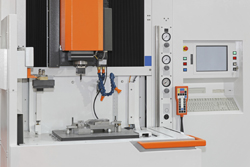Metal machine parts sensitive to impending damage
Given the ubiquitous presence of plastic components and parts in everyday life, it is not difficult to understand the importance of the injection moulding machines used to make many of them. Despite their value, the machines that form melted plastics in metal moulds are currently subject to as much as 20 % downtime and achieve on average only 60 % utilisation. Surface damage to metal machining parts is responsible for important EU losses due to breakdown and delays in production and delivery in many manufacturing sectors. The real-time structural monitoring solution for metal machine parts developed by the EU-funded project 'Ultra-thin conductive ceramic mesh to monitor stress and wear on a steel surface' (MESMESH) is thus expected to have major impact on the competitiveness of EU manufacturing. The MESMESH solution was made possible through a variety of innovations in technology, materials and algorithm development. Femtosecond laser etching was used to make microscopic grooves on the steel. The scientists developed special conductive ceramics made into fibres and sintered into a thin layer mesh on the metal part. Holes and notches micro-machined into the tiny ceramic fibres increased bonding to ultra-thin wires to provide sensing. Finally, novel wear-prediction algorithms were developed to detect wear and damage in production environments. Investigators demonstrated a pre-commercial prototype mould with MESMESH sensing and measurement technology tested and verified in a commercial application. The technology is easily adaptable to structural health monitoring (SHM) of many other metal parts such as axles, drive shafts, brake pads and dies for extrusion. Expected benefits are numerous, including reduction of scrap from faulty parts due to mould damage, enhanced product quality, decreased downtime and major cost savings. Overall, the MESMESH consortium delivered real-time SHM technology for complex metal machine parts superior to other alternatives currently available in terms of technology or price, or both. Implementation is also expected to have important side-effects such as reduced energy consumption, reduced emissions and conservation of natural resources.







